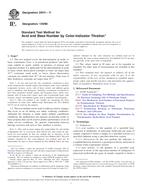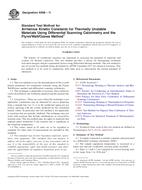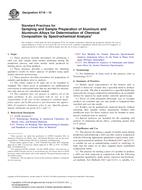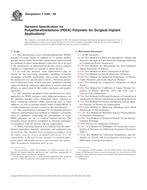ASTM D974-11
- Standard Test Method for Acid and Base Number by Color-Indicator Titration
- standard by ASTM International, 05/15/2011
- Publisher: ASTM
$26.00$52.80
1.1 This test method covers the determination of acidic or basic constituents (Note 1) in petroleum products and lubricants soluble or nearly soluble in mixtures of toluene and isopropyl alcohol. It is applicable for the determination of acids or bases whose dissociation constants in water are larger than 10−9; extremely weak acids or bases whose dissociation constants are smaller than 10−9 do not interfere. Salts react if their hydrolysis constants are larger than 10−9.
Note 1 - In new and used oils, the constituents considered to have acidic characteristics include organic and inorganic acids, esters, phenolic compounds, lactones, resins, salts of heavy metals, and addition agents such as inhibitors and detergents. Similarly, constituents considered to have basic properties include organic and inorganic bases, amino compounds, salts of weak acids (soaps), basic salts of polyacidic bases, salts of heavy metals, and addition agents such as inhibitors and detergents.
Note 2 - This test method is not suitable for measuring the basic constituents of many basic additive-type lubricating oils. Test Method D4739 can be used for this purpose.
1.2 This test method can be used to indicate relative changes that occur in an oil during use under oxidizing conditions. Although the titration is made under definite equilibrium conditions, the method does not measure an absolute acidic or basic property that can be used to predict performance of an oil under service conditions. No general relationship between bearing corrosion and acid or base numbers is known.
Note 3 - Oils, such as many cutting oils, rustproofing oils, and similar compounded oils, or excessively dark-colored oils, that cannot be analyzed for acid number by this test method due to obscurity of the color-indicator end point, can be analyzed by Test Method D664. The acid numbers obtained by this color-indicator test method need not be numerically the same as those obtained by Test Method D664, the base numbers obtained by this color indicator test method need not be numerically the same as those obtained by Test Method D4739, but they are generally of the same order of magnitude.
1.3 The values stated in SI units are to be regarded as standard. No other units of measurement are included in this standard.
1.4 This standard does not purport to address all of the safety concerns, if any, associated with its use. It is the responsibility of the user of this standard to establish appropriate safety and health practices and determine the applicability of regulatory limitations prior to use.
A2.1.1 This test method is intended for determining the acceptability of p-naphtholbenzein indicator for use in Test Method D974 with regard to color change over a pHr range.
Related Products
ASTM E698-11
Standard Test Method for Arrhenius Kinetic Constants for Thermally Unstable Materials Using Differen..
$26.00 $52.80
ASTM E716-10
Standard Practices for Sampling and Sample Preparation of Aluminum and Aluminum Alloys for Determin..
$26.00 $52.80
ASTM F2026-08
Standard Specification for Polyetheretherketone (PEEK) Polymers for Surgical Implant Applications..
$23.00 $46.80
ASTM E1870-98
Standard Test Method for Odor and Taste Transfer from Polymeric Packaging Film..
$30.00 $60.00





